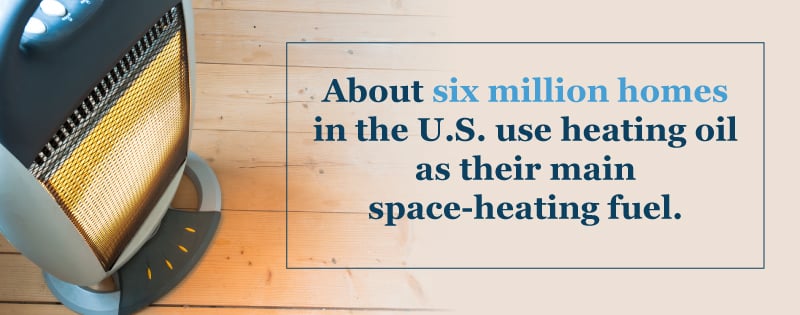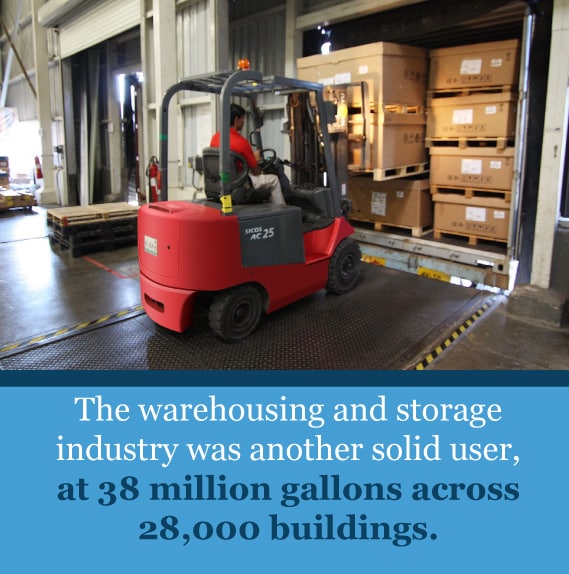
What Is Heating Oil?
Home heating oil (HHO) is a petroleum product that is refined from crude oil. All home heating oil products are required by the Internal Revenue Service (IRS) to be colored with a colored dye, usually red or pink, which marks them as not for highway use. This exempts those products from the state, local and federal taxes applied to fuels that are sold for use on public roadways and also marks them as illegal for public roadway use.

About six million homes in the U.S. use heating oil as their main space-heating fuel, with most of those homes located in the northeast.
According to the U.S. Energy Information Administration, the northeast accounted for 84 percent of residential heating oil sales in 2015, with the south making up nine percent, the Midwest making up five percent, and the west making up only three percent.
While the northeast controls a large chunk of the U.S. home heating oil market, it also accounts for a significant share of the commercial sector, too — 37 percent alone in the 2015 census year.
Whether the heating need is residential or commercial, the primary use for heating oil is in the area of space-heating. This means demand for heating oil is not only seasonal, but it varies with temperatures as well. There’s even a time of the year where heating oil sales are particularly high, dubbed “heating season,” which is the months of October through March.
A Brief History of Oil
The commercial U.S. oil industry began when a man by the name of Edwin Drake discovered oil in the area around Titusville, Pennsylvania in 1859. While others had been finding oil as early as the 1820s and 1830s, this oil was mostly an accidental byproduct of wells that had initially been drilled for salt brine or for drinking water, as was the case with the Ontario Springs drinking well in 1858.
Drake was the first person in the United States to drill a well specifically for oil, and it was his discovery, as well as the additional follow-up drilling that occurred, that laid the groundwork the U.S. oil industry as it stands today, specifically by providing a supply of oil large enough to support business ventures of some magnitude.
Following in the footsteps of that first well, others began to drill throughout the Appalachian Basin and the western Appalachian mountains. This led to further drilling in western Pennsylvania and up into New York, with the first commercial oil well in New York drilled in 1865. Oil drilling soon spread outward from New York and down the Ohio River valley in Ohio, Kentucky and what is now West Virginia.
However, the Appalachian Basin remained the premier oil-producing region in the United States all the way through the early 1900s.
Once the initial boom had swept the northeast, prospective oil drillers soon found black gold in other areas such as Oklahoma in 1897, Louisiana in 1906 and Texas in 1930. Oil was also drilled for in Colorado in 1862, California in 1865 and on the Gulf coast by 1901.
Once crude oil became a viable alternative to whale oil as a means of illumination, federal price controls soon followed by way of the Natural Gas Act of 1938. The last federal price controls on crude oil were struck down by the Natural Gas Wellhead Decontrol Act of 1989, which ensured their removal by July of 1993.
Home Heating Oil Facts
More than 30 million Americans depend on oil-powered heating for their homes. Home heating oil is one of the many distillates of crude oil, along with:
- Gasoline
- Kerosene
- Diesel fuel
- Jet fuel
While this list of distillates may make you think home heating oil is not a clean fuel, in fact, the opposite is true. The heating oil used today is 90 to 95 percent cleaner than it was during the 1970s, and the overall sulfur content of home heating oil has been reduced by 93 percent since the late 1980s.

Additionally, many states in the northeast have passed regulations calling for ultra-low sulfur diesel (ULSD), which requires the sulfur content of any home heating oil to be less than 15 parts per million of the given heating oil, with New York passing such a law in 2012.
Massachusetts, New Jersey and Vermont each passed the first phase of a similar law in 2014 that required the sulfur content of any home heating oil sold in state to be less than 500 parts per million. Maine passed its own first phase ULSD law in 2016, requiring less than 50 parts per million of sulfur.
That same year, New Jersey joined New York in requiring ULSD, with Massachusetts, Maine and Vermont expected to require ULSD by 2018.
The push for ultra-low sulfur diesel comes along with improvements to home heating oil systems that allow those systems to “reburn” fuel, cutting down on emissions and keeping any soot that remains inside the oil tank. The combination of these two technologies also means the average home has been able to cut its oil consumption by 33.6 percent over the last 30 years.
Until renewable resources such as solar and wind catch up, home heating oil remains one of cleanest and cheapest ways to heat one’s home or business, especially when compared to natural gas.
Not only was home heating oil less expensive than natural gas throughout most of the last two decades, but the prices of natural gas have gone up over the past two years and are expected to continue to rise.
Conversion to a natural gas furnace just adds to the expense. Oil tank removal, chimney installation, new plumbing and duct work can drive the cost of conversion to natural gas upwards of $9,000 — more if extra work needs to be done like water heater and gas line installation. This doesn’t include taxes and permits, either.
Heating oil supplies are also much more plentiful than supplies of natural gas. The Strategic Petroleum Reserve has over 700 million barrels alone, with the Northeast Home Heating Oil Reserve adding a further million more. Renewable biofuel options only add to this already considerable stockpile.
Compare this with natural gas. Rising natural gas consumption could lead to rising prices along with the development of a competitive supply-and-demand market on a global scale. This prediction of higher prices is added on to the already high prices of natural gas, which comes as a result of the currently inefficient natural gas pipeline system.
Natural gas is also an “interruptible” resource: Utilities companies may need to shut off gas services to larger users, such as schools, hospitals and factories in order to meet demand during high-usage periods. When their services are interrupted, these users turn to home heating oil.
In addition to shutting off services for “interruptible” users, natural gas companies also have to shut off during road construction, pipeline repair or during emergencies. Since home heating oil is available from an on-site tank, it can be used whenever it is needed.
Uses of Heating Oil
There are two different kinds of heating oil, each with its own uses: light heating oil, which is a middle distillate, and heavy heating oil, which is a type of fuel oil.
Light heating oil is used primarily as a space-heating agent, but can also be used for power generation by means of a boiler. The use of light heating oil for power generation is especially prevalent in factories, hospitals, residential homes and schools in places where natural gas is unavailable or where electricity cannot reach. During the 2015 census year, there were 4.02 billion gallons of heating oil sold to residential customers in the United States, according to the U.S. Energy Information Administration.
Light heating oil also finds its use among the manufacturing industry, with dozens of industries using light heating oil throughout the 2010 census year alone. For example, the foods industry used half a million barrels by itself, split between grain milling, sugar manufacturing, fruit and vegetable preservation, dairy products and animal slaughter and processing.
The beverage industry wasn’t left behind, either: It too used about half a million barrels of oil during the year.
Other users included the wood industry — in sawmills, veneer, plywood and paper products — the petroleum industry — through asphalt paving mixture and other petroleum products — the fertilizer industry, the pharmaceuticals industry — including pharmaceutical preparation — and, of course, the plastics industry, at half a million barrels or less.
In contrast to light heating oil’s primary use as a heat generator, heavy heating oil is primarily used to generate power, most frequently for the marine diesel engines of the maritime shipping industry. It has been a standard used by the American Bureau of Shipping since at least 1984.
However, heavy heating oil also sees use as a power generator in non-shipping uses.
According to the Commercial Buildings Energy Consumption Survey for 2012, educational buildings used 205 million gallons of heavy heating oil across 30,000 buildings, averaging out to just a little under 9,000 gallons per building. The health care industry wasn’t far behind: It used 142 million gallons across 23,000 inpatient and outpatient centers, or a little over 6,000 gallons per building.
Other areas used quite a bit, as well: Office buildings used 131 million gallons and the service industry used 118.
The lodging and mercantile industries used 61 and 69 million gallons, respectively, with more than two thirds of mercantile heating oil going toward retail areas other than malls.
There were even some areas that used more than some people would have expected. For example, the 27,000 public assembly areas surveyed in 2012 used a total of 48 million gallons between them, or about 1,777 gallons per building.
Buildings of religious worship, such as churches, used 39 million gallons of oil, which comes out to a little under 1,700 gallons for each of the 23,000 religious buildings surveyed for 2012.

The warehousing and storage industry was another solid user, at 38 million gallons across 28,000 buildings — averaging out to a little under 1,500 gallons per storage building.
Public order and safety services also used a respectable amount of oil, having used 17 million gallons to power 34,000 buildings, according to the 2012 survey, which amounts to 500 gallons of heavy heating oil per building.
Finally, 28,000 other buildings, whose purposes were not disclosed during the survey, used a whopping 71 million gallons of heating oil during the 2012 survey year, meaning that each building used a little more than 2,500 gallons of heating oil over the year.14
In addition to its use in various industries as fuel to generate power, heavy heating oil is also used in some manufacturing industries as a nonfuel feedstock, which is an input into a petrochemical process.
According to census data for the 2010 census year, the chemicals industry as a whole used 14 million barrels of heavy heating oil as nonfuel feedstock, though the data fails to disclose exactly which sub-sectors of the industry used how much.
Several other industries used about half a million barrels each, such as the asphalt paving industry, the food and beverage industries, the wood industry — specifically the veneer and plywood sub-sectors — the metals industry and the cement industry.
The sheer number of industries that heating oil is involved in — not to mention the millions of residential customers — shows that no matter whether it’s light heating oil or heavy heating oil, the heating oil industry isn’t going anywhere any time soon.
For Stellar Service, Choose Marstellar
Since 1998, Marstellar Oil & Concrete has delivered a high-quality home heating oil experience to customers throughout the Central Pennsylvania area. Locally owned and operated, Marstellar is committed to ensuring you have the facts needed to ensure that your home heating oil expenses are as low as they can possibly be this winter.
Not only does Marstellar allow small orders as low as 50 gallons, but around-the-clock ordering is available through the online form on our website. We strive to keep you updated with up-to-the-minute pricing as well, so you have all the information necessary to make your home heating decision.
Once you decide to place an order with us, rest assured you’ll enjoy some of the best customer service in the Central Pennsylvania area. We know your time is valuable, so not only do we offer an incredibly fast standard delivery turnaround time within two business days of receiving your order, but we also offer same-day express delivery for just $49.
The Marstellar team can deliver to almost anywhere in the Central Pennsylvania area, including Cumberland, Dauphin, Juniata and Perry counties, as well as northern York county.
If you’re interested in getting some of the best home heating oil prices in the Pennsylvania area, either contact us through our website for more information or fill out our online ordering form so we can match you up with the oil quantities that best fit your home heating needs, whether it be 50 gallons or 500.


